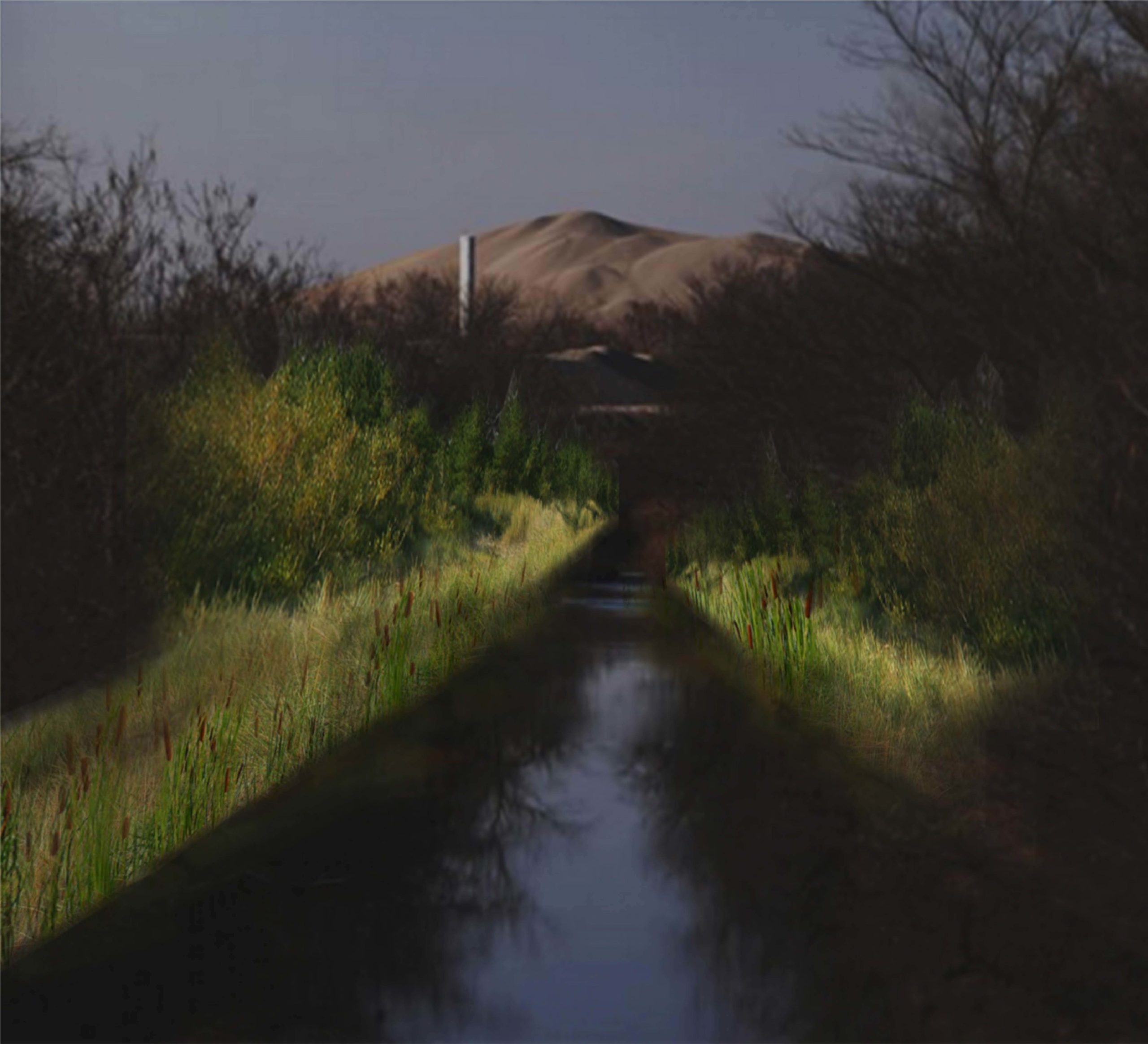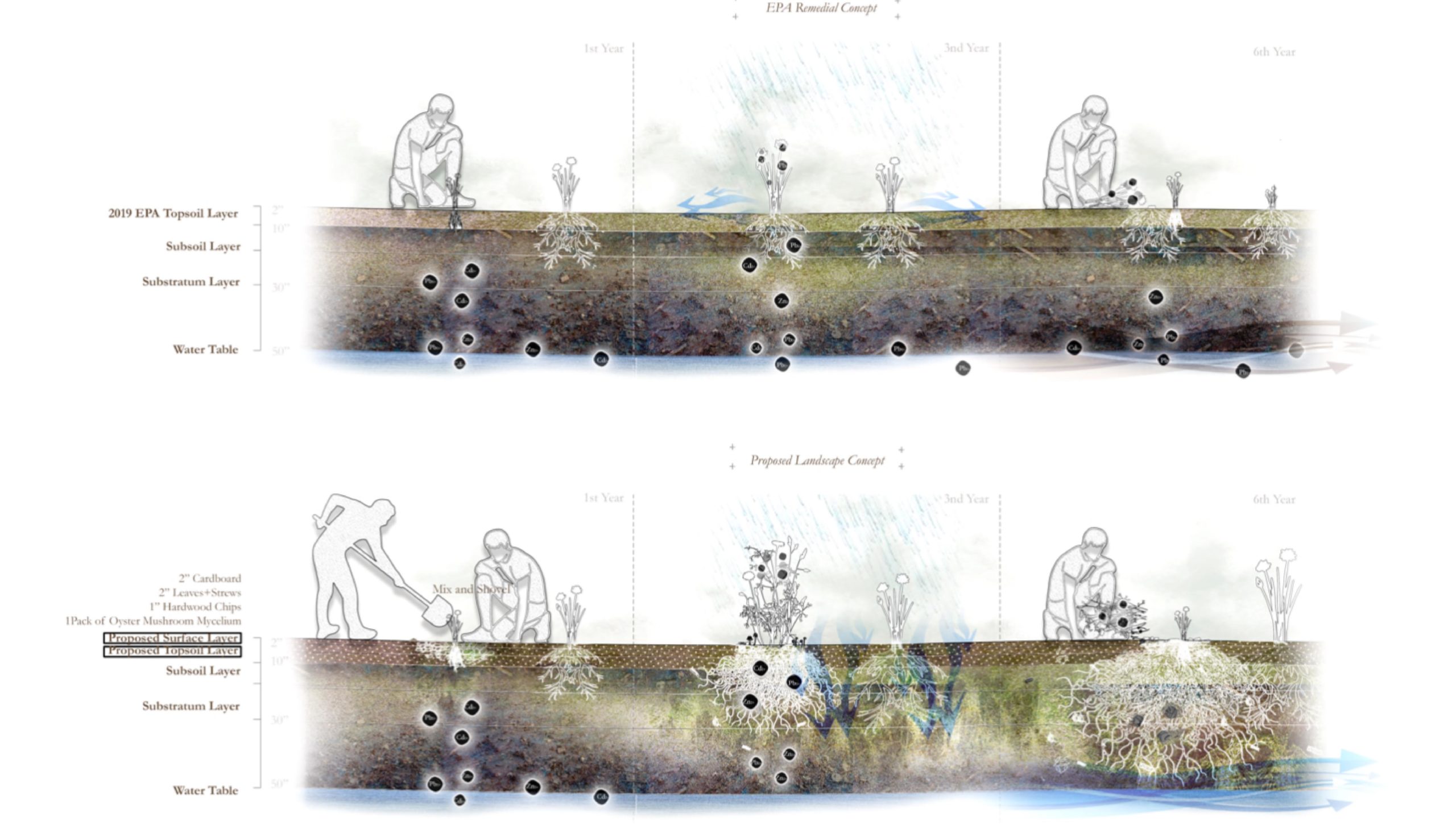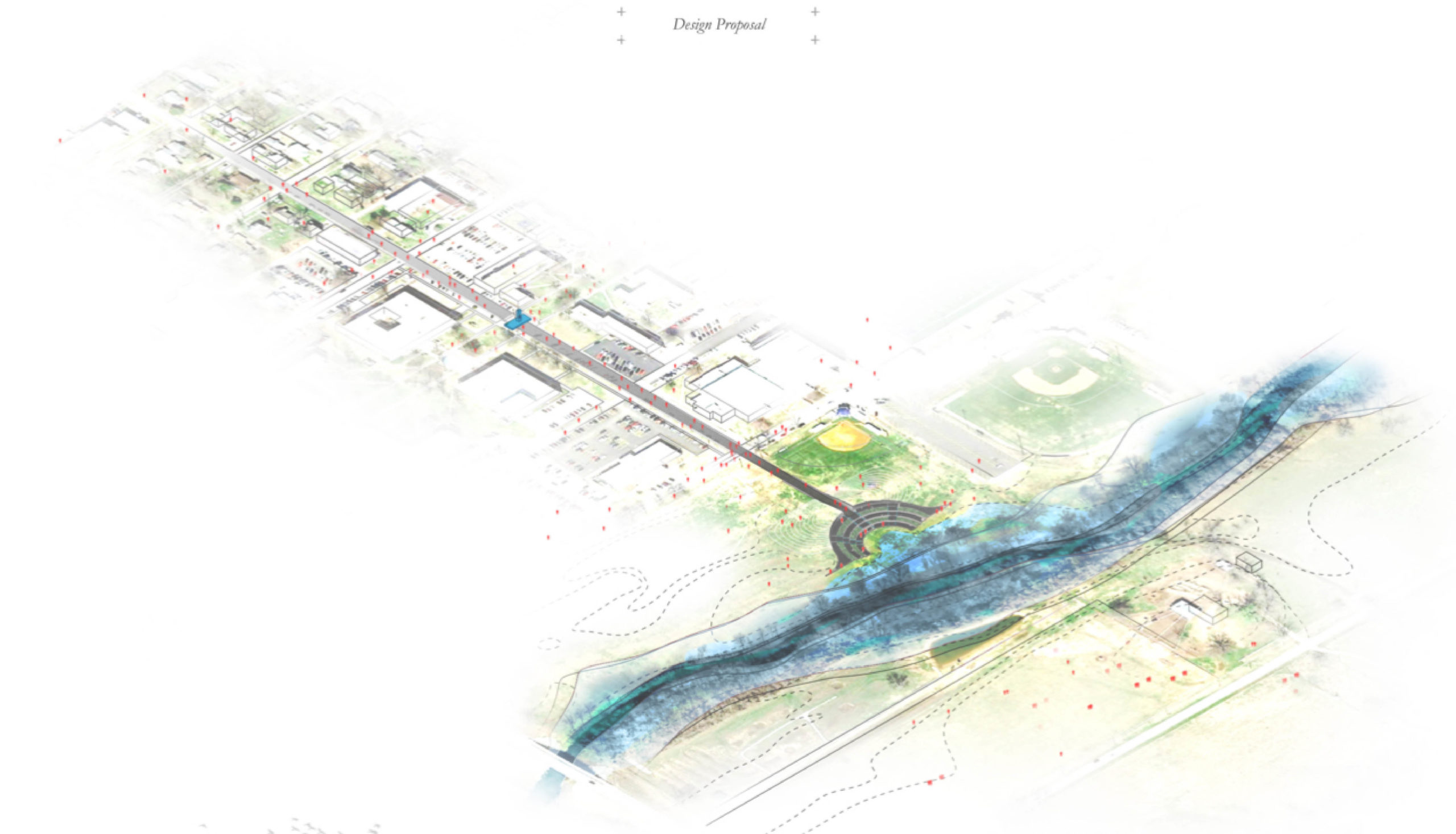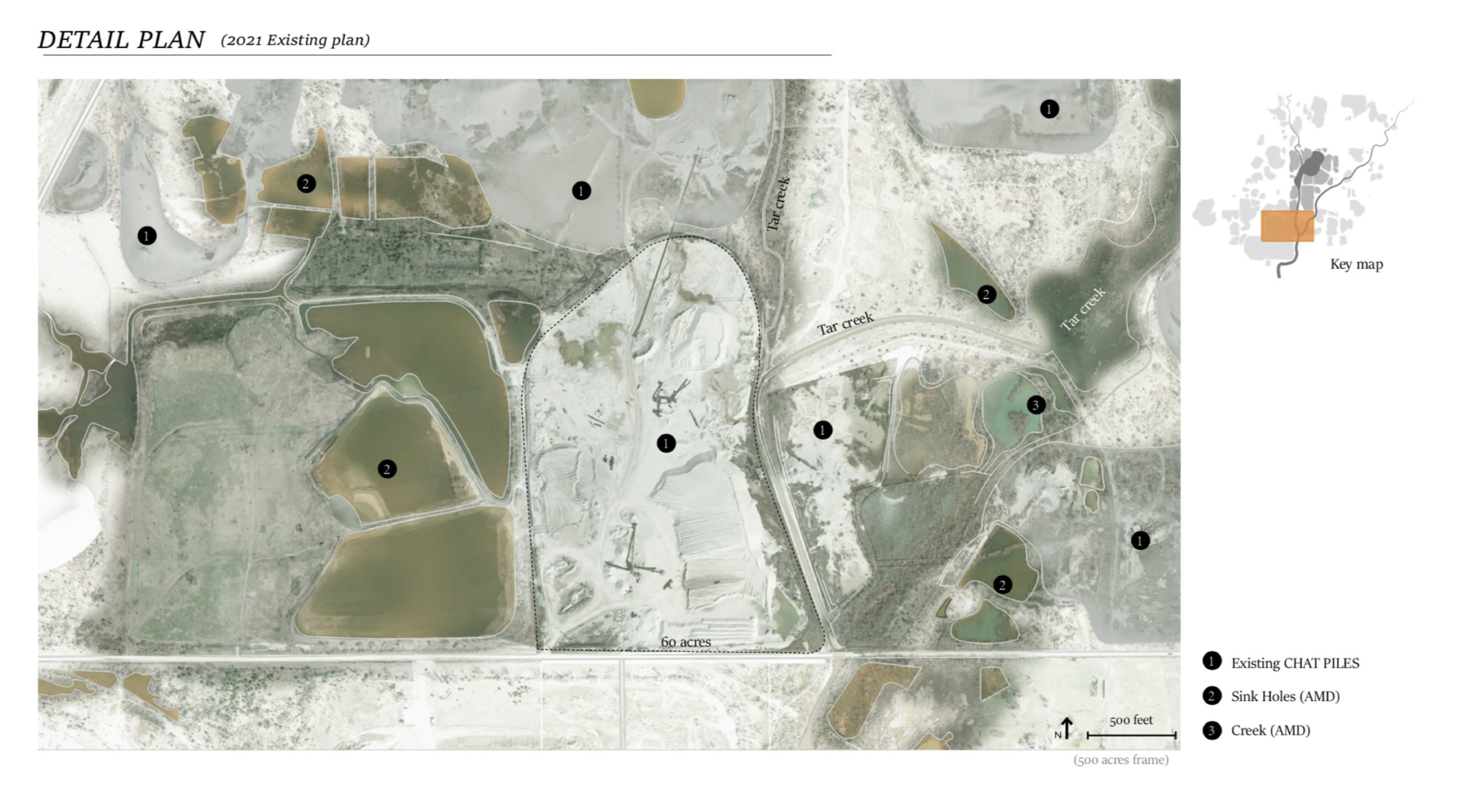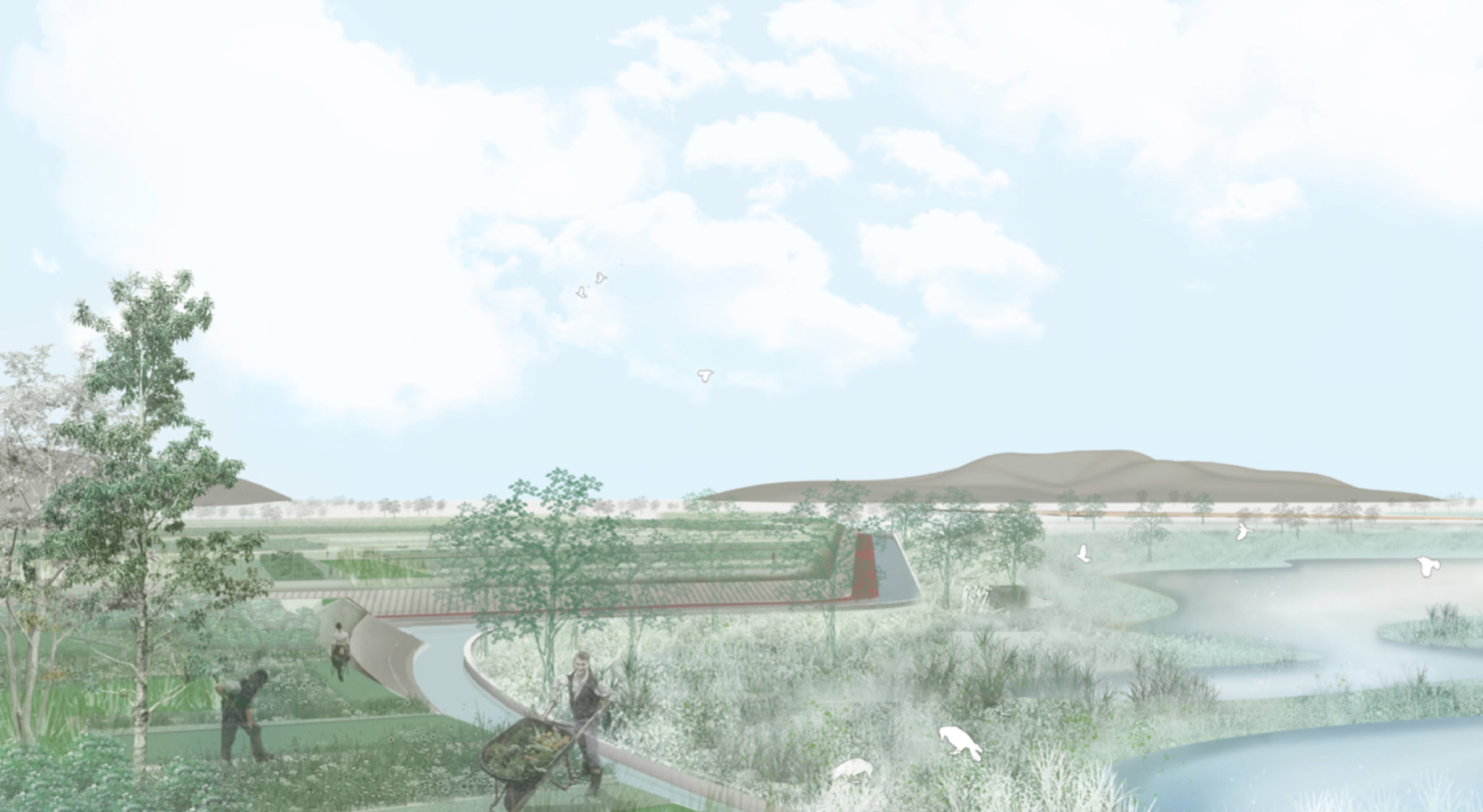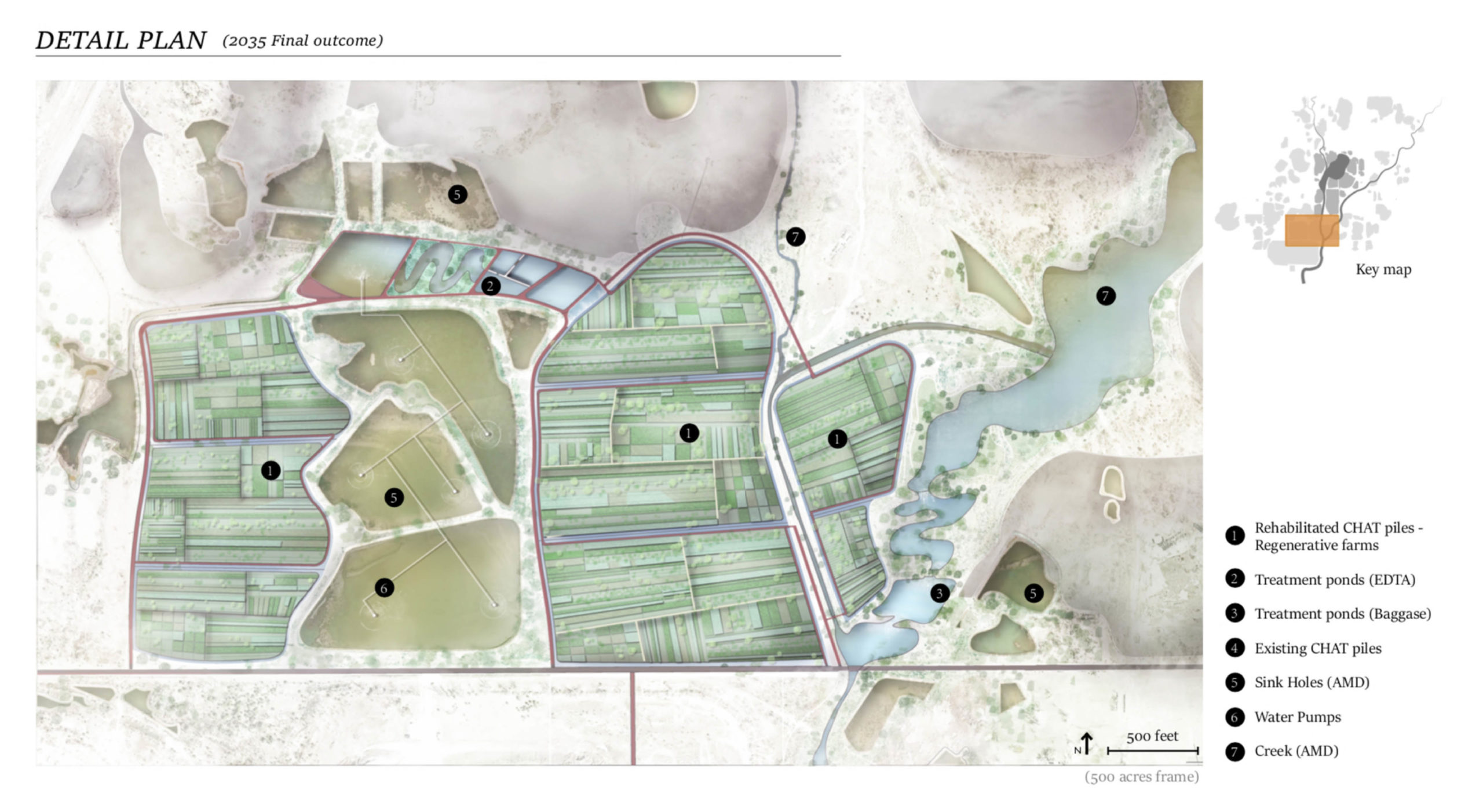Envision a broad expanse of barren gray mounds riven with erosion channels. Pools of viridian, ochre, and bright russet water fill low areas between the piles. Some of these drain into a meandering multicolored creek that makes its way through rank grass and shrubs. A hot breeze lifts gritty dust from the mounds and swirls it across empty roadways. Its dull dry odor mixes with the sharp acidic tang of the creek. A trickle of water and the whisper of rushing air fill the quiet. Residential streets among the huge piles slowly narrow under encroaching weeds, and cracked concrete slabs hold back overgrown lawns. Only memories of the houses remain along 5th, 6th, and 7th, along Cherokee, Oneida, and Ottawa, and along Treece, Picher, and Main Streets. At Memorial Park a black gorilla on a red pedestal announces a 1984 football victory—Oklahoma division 1A. A block away, rising higher than the gray gravel piles called “chat,” a water tower announces: “PICHER Gorillas since 1918.”
From an airplane or satellite, Picher, Oklahoma, appears as an anomaly in the endless green grid of agricultural land at the center of the United States. Huge irregular gray blots and dark pools interrupt the geometric precision of roads, and the colorful smear of Tar Creek runs diagonally through the town. Abandoned a decade ago—like its neighbors Cardin and Douthat, Oklahoma, and Treece, Kansas—Picher reveals a legacy of environmental indifference and staggering injustice.
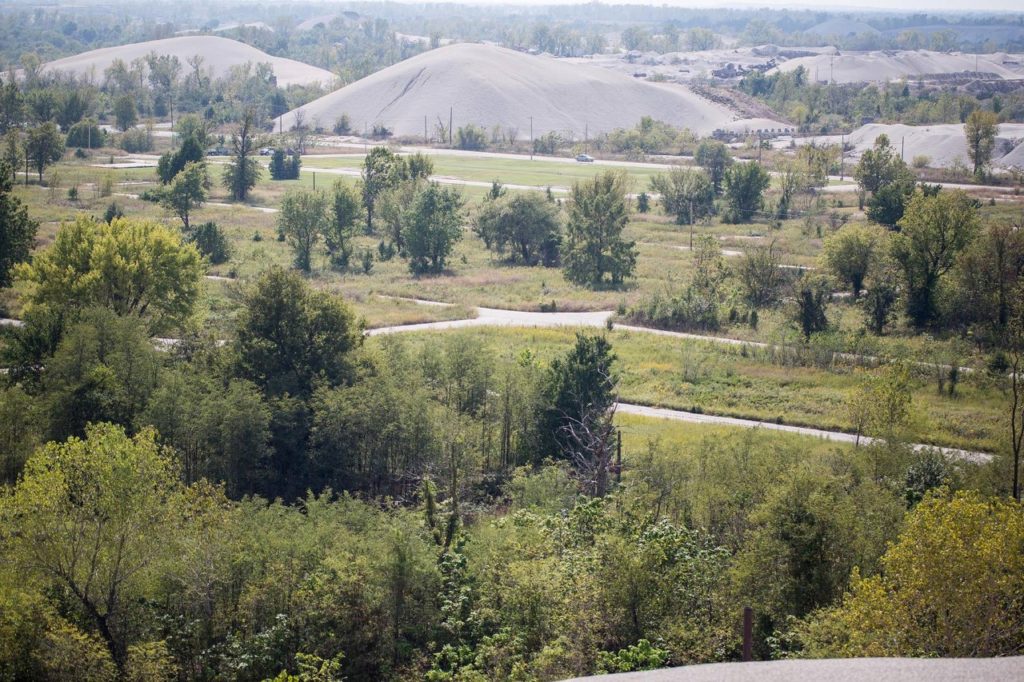
For just over 70 years, the town served an immense lead and zinc mining complex. Its corporations enjoyed virtually unregulated access to billions of dollars’ worth of buried minerals, which it extracted aggressively until profits declined in the early 1970s. Members of the Quapaw Nation, who owned parts of the land, derived little benefit, because they had been forced by the federal government to sign unfavorable leases during the mid 1890s under the pretext that they were “incompetent,” incapable of using their own land profitably. Consequently, the Quapaw tribal members received none of the mining profits but were left with the toxic and hazardous waste when the mines closed.
Dust from the chat piles contain high concentrations of lead, zinc and cadmium; ground water is intensely acidic; and underground excavations give way unexpectedly under lawns, houses, streets, and the once-proud home of the Picher Gorillas. The Environmental Protection Agency designated the area as the “Tar Creek Superfund Site” in 1983 and eventually bought out the residents of Picher, Cardin, Douthat, and Treece. Disincorporated and abandoned by 2010, vestiges of the towns remain among the toxic piles and sinkholes. Cleanup has been exceedingly slow, and until recently, the Quapaw tribal members were excluded from the remediation effort.
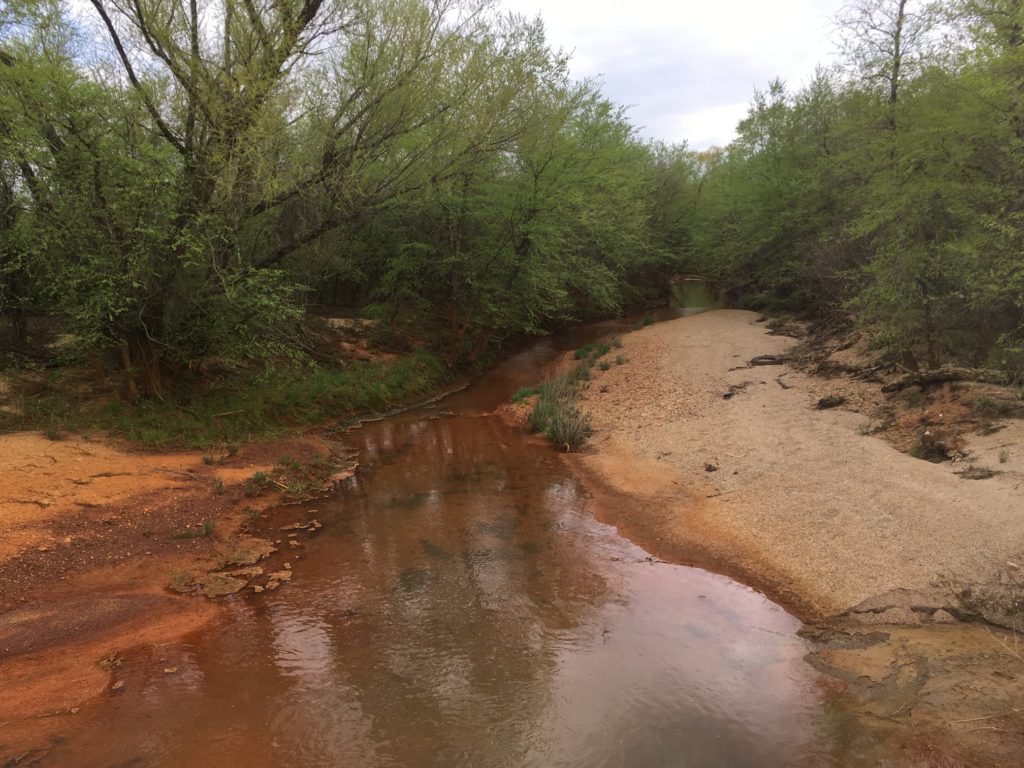
GSD professor Niall Kirkwood describes this passionately as “a horrific story. . . 120 years of environmental injustice.” By design, the brutal legacy of the mines haunted his spring 2021 landscape architecture studio, “Tar Creek Remade: Environmental Legacy, Toxic Terrain and Re-Imagining the Future in the Tri-State Mining Area, Ottawa County, Oklahoma, USA.” From the beginning, Kirkwood challenged his 10 students to take on this immense problem of Tar Creek—a project “so utterly terrifying and so utterly complex that any sense of a resolution within a 15-week period is almost impossible”—with energy and creativity, but also realistically, anticipating small steps and a long time frame. It is crucial, he warned, to anticipate that progress will occur only “little by little” over centuries. Accordingly, their task was to “to go down to the micro-scale on the site. . .” and to propose “test experiments. . . they could scale up over the site—a hundred times, a thousand times, ten thousand times.”
In addition to many technical experts, Kirkwood invited two long-time participants in the Tar Creek evolution to advise the class. Rebecca Jim and Earl Hatley, Quapaw tribal advisors and co-founders of Local Environmental Action Demanded (LEAD), based in Miami, OK, are deeply familiar with the frustratingly slow progress and long time frame at Tar Creek. Since 1997, their non-profit organization has advocated for all the tribal and non-tribal communities in the area, pointing out that “the EPA and State of Oklahoma have spent more than $300 million at Tar Creek—yet the creek still flows orange, tailings piles still loom on the horizon and children are still poisoned by lead.” In addition, environmental scientist Dr Kurt Frantzen, an expert in large scale environmental damage and superfund sites advised the class on issues of pollutants, site remediation and risk. Through more than a hundred hours of class time the three advisors helped guide the students through some of the otherworldly complexities that are so central to their everyday lives.
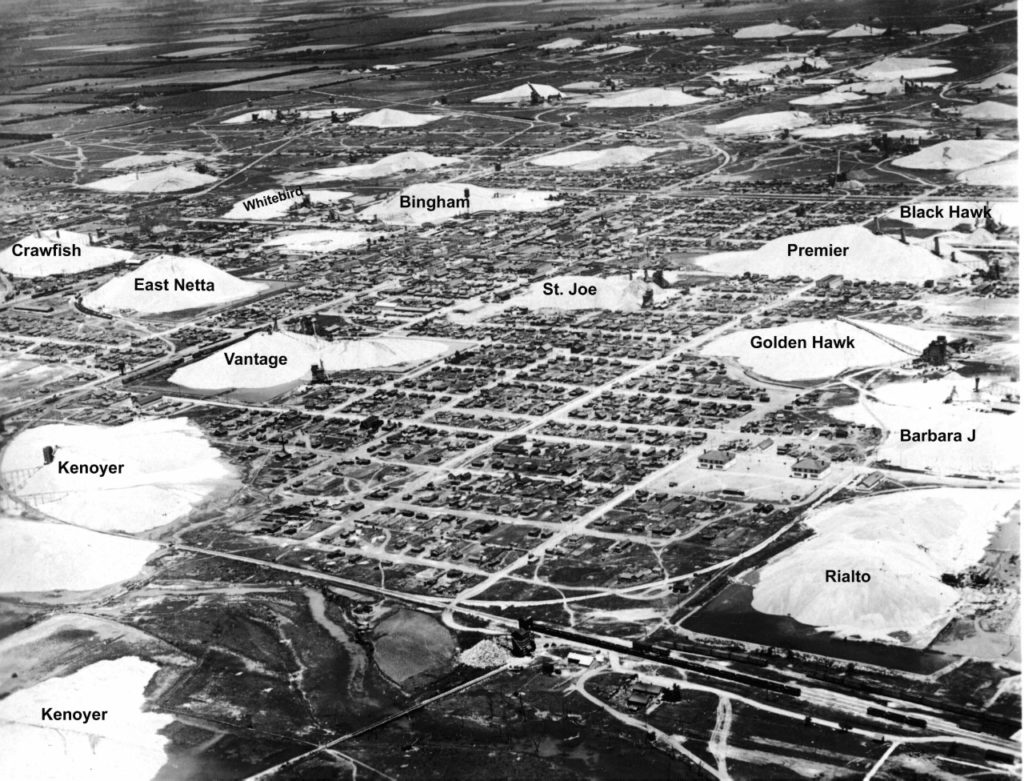
The studio unfolded in four stages: “Legacies,” “Voices,” “Wisdom,” and “Futures.” During the first weeks of the semester, Kirkwood explains, “We start the course with a land acknowledgment. . . we get the students thinking about the idea that sites are not just given to you; this one has a very deep history that is tied to the Indigenous people.” Reinforcing the understanding that all sites have legacies, the students produced two acknowledgments—one for Tar Creek and another for where they were living during the semester (since the class met remotely).
Subsequently, the students read texts, watched videos, gathered images, and listened to the voices of Tar Creek area residents so that they could begin to formulate initial “hypotheses”—first proposals of what they might test at the site. Over the course of several weeks, they interrogated and adjusted their hypotheses. During this third phase, which brought them to the midterm, they began to consider how their proposals might work for environmental remediation on small test plots, but they also sought to “infuse that within a cultural structure,” by adding programs that would accommodate people’s needs—for trails, agriculture, hunting, food security. During the final stage of the studio, the students more fully envisioned how the experiments might develop over the long term to address the question “what’s the future of this place?” This entailed not just an understanding of the sometimes agonizingly slow pace of remediation and cultural change, but also the inevitable interactions of these experiments with changes in larger global forces—shifting populations, rising temperatures, more violent storms, and new technological developments in remediation and clean-up.
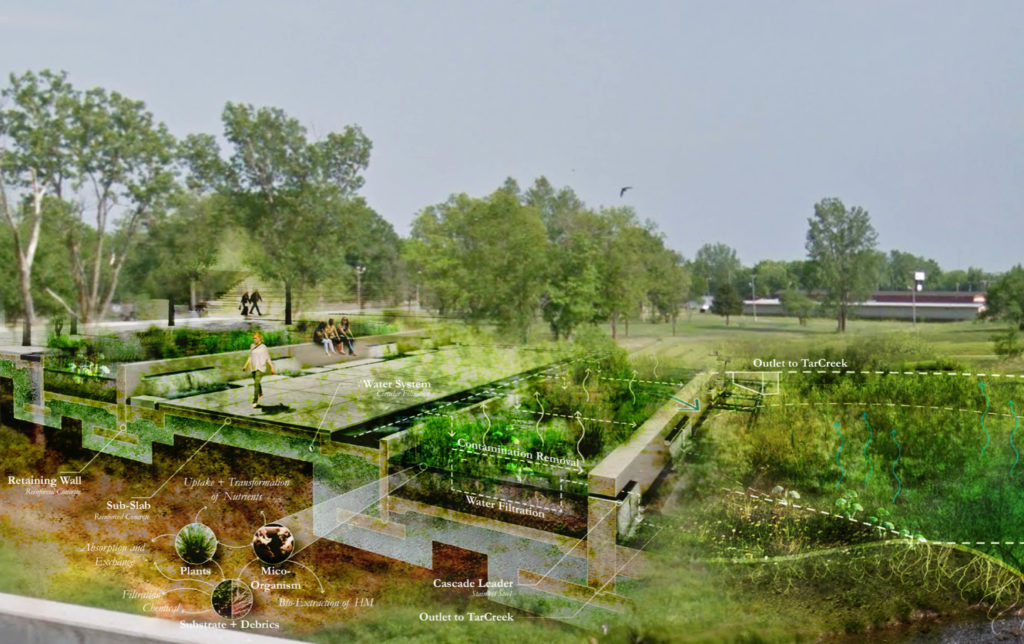
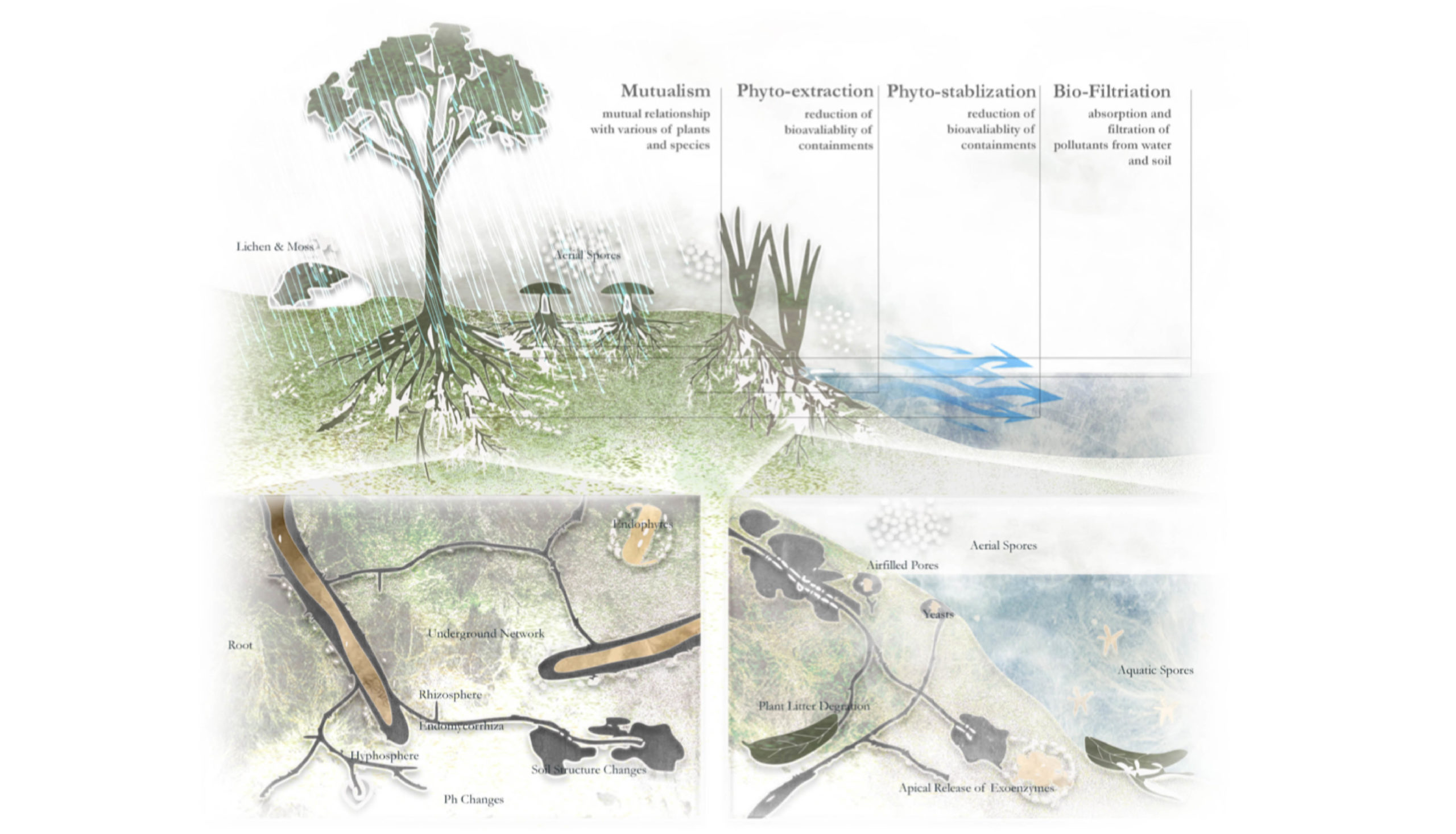
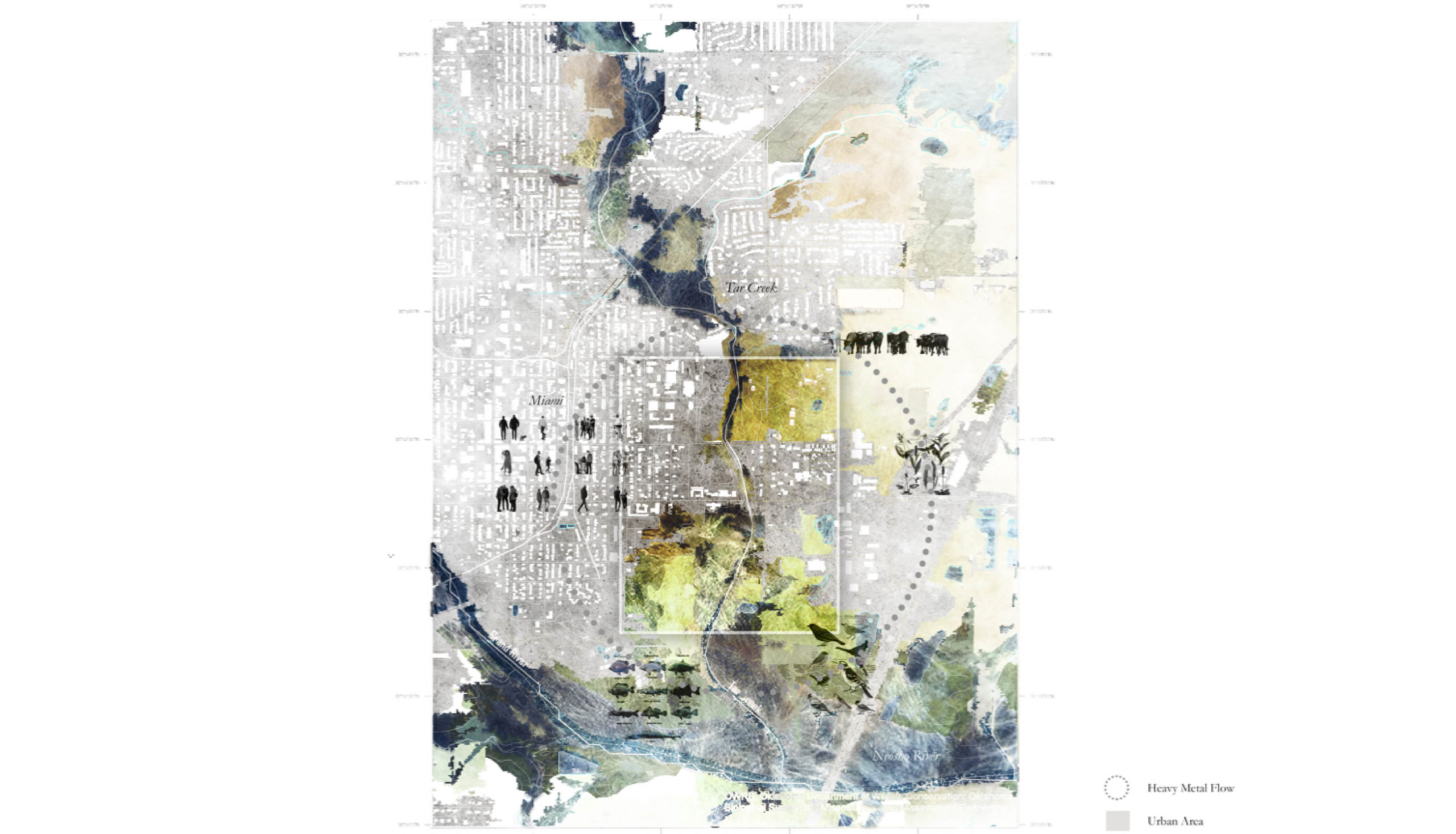
By the end of the semester, the students produced a wide range of proposals for the blighted site—addressing the contaminated water, the toxic chat piles, and the perilous sinkholes while also considering the residents of the area and their livelihoods. In one project, microorganisms would invisibly decontaminate the water and soil on many small sites where people could come together on the cleansed ground to play, learn, and enjoy each other’s company. Another project looked back at the legacy of the Quapaw Nation, understanding the community as mound builders who could reclaim their ancient expertise and reshape the chat piles to redirect hazardous airflows and accommodate beneficial plant life. One student took on “something no one has even considered,” Kirkwood says, choosing “to remediate groundwater contamination in the numerous sinkholes.” Surprising for its boldness, the project proposed using the collapsed ground as remediation ponds—monitored over the long term through robotics—so that, eventually, “the landscape could be loved.” Other students developed sophisticated plans for the slow reclamation of the land and water: regenerating the native prairie, rerouting Tar Creek around the toxic site, and highlighting the slow transformation of colors in a healing landscape.
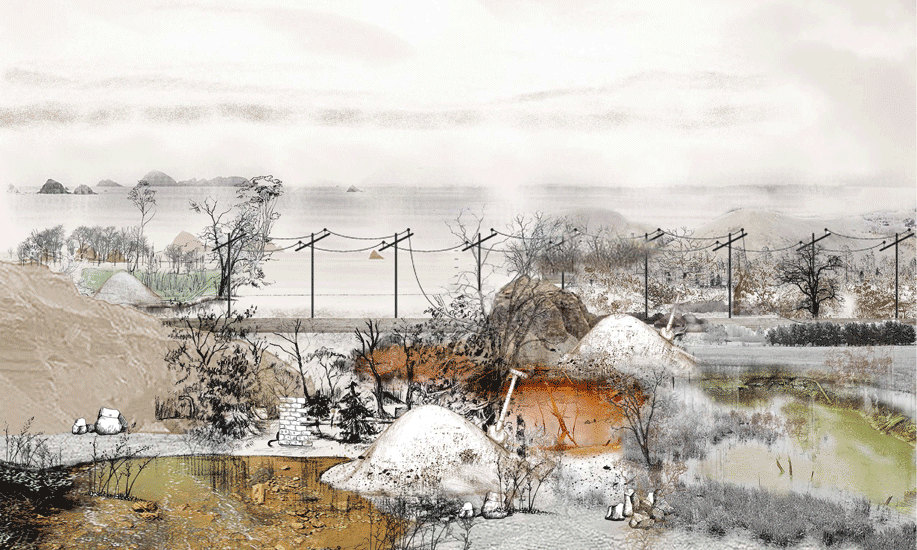
A day after the final review, Rebecca Jim sat down to recall the students’ efforts and generosity, writing: “I have long thought this place will only find the solutions and the reclamation deserved by establishing relationships with people with vision, skills and training, and ultimately the power who will see this place but also see and experience us, each of us they encounter as people who matter, who have lives that matter and desires to live in places students like these can imagine. . . . These students took on Tar Creek and with their projects ‘Remade’ it all and gave hope where there has been none.” Rebecca Jim zeroes in on the essence of good design: It can and must contend with the physical substance and challenges of a place, but design is, most importantly, about people, about justice, about care.
The daunting story of Tar Creek—“so utterly terrifying and so utterly complex”—calls out for this kind of care. But Kirkwood points out that every country has Tar Creeks, places where global forces fall heavily and unjustly on the land and the people who live there. These are difficult but appropriate subjects of study for designers, he says, even in short-term academic studios where resolutions may be unattainable. The goal is to cultivate expertise and creativity, as well as humility and generosity. At the outset of “Tar Creek Remade,” Kirkwood cautioned the students to consider that in their designs, what matters is not “the ‘stamp’ or ‘signature’ of the author” but “ethical and cultural attitudes to land, landscape and the natural world” and a genuine concern for the people who work to repair the land and who live on that land.
